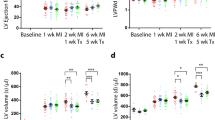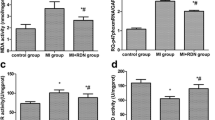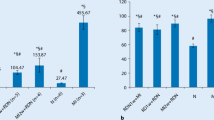Abstract
We examined the impact of acute myocardial ischemia followed by reperfusion (AMI-R) on local and circulating renin–angiotensin system (RAS) in a swine model. The mid left anterior descending artery (n = 6) was occluded for 1 h, followed by reperfusion for 2 h. Monastryl blue/triphenyl tetrazolium chloride staining identified the area-at-risk (AAR) and infarction. A second group of control animals underwent sham operations (C: n = 4). Myocardial expression of angiotensinogen (AGT), renin, chymase, angiotensin converting enzyme (ACE), angiotensin II (Ang II), Ang II type1 receptor (AT1R) and Ang II type 2 receptor (AT2R) in the AAR and the non-ischemic left ventricle (NLV) was assessed. Serum level of these proteins at baseline and at the end of reperfusion was also examined. Chymase (P < 0.05), ACE (P < 0.05), Ang II (P < 0.05), AT1R (P < 0.05) and AT2R (P < 0.05) expressions were found to be significantly higher in the AAR compared to the NLV and C whereas no significant differences were found for AGT (P = 0.58) and renin (P = 0.38). Serum concentration of ACE was significantly higher at the end of reperfusion than at baseline (P < 0.01), whereas no significant difference was found for chymase (P = 0.71), AGT (P = 0.57) and Ang II (P = 0.19). Immunohistochemistry of myocardial sections demonstrated significantly higher expression of ACE (P = 0.02), AT1R (P = 0.01), AT2R (P = 0.02) and Ang II (P < 0.01) in the AAR as compared to the NLV, whereas no significant difference was found for renin (P = 0.39). In conclusion, AMI-R resulted in significantly higher expression of specific cardiac RAS components in AAR compared to the NLV in the acute period.





Similar content being viewed by others
References
Amedeo Modesti P, Zecchi-Orlandini S, Vanni S, Polidori G, Bertolozzi I, Perna AM, Formigli L, Cecioni I, Coppo M, Boddi M, Serneri GG (2002) Release of preformed Ang II from myocytes mediates angiotensinogen and ET-1 gene overexpression in vivo via AT1 receptor. J Mol Cell Cardiol 34:1491–1500
Bafford R, Sui XX, Wang G, Conte M (2006) Angiotensin II and tumor necrosis factor-alpha upregulate survivin and Kruppel-like factor 5 in smooth muscle cells: potential relevance to vein graft hyperplasia. Surgery 140:289–296
Beil WJ, Schulz M, McEuen AR, Buckley MG, Walls AF (1997) Number, fixation properties, dye-binding and protease expression of duodenal mast cells: comparisons between healthy subjects and patients with gastritis or Crohn’s disease. Histochem J 29:759–773
Caughey GH, Raymond WW, Wolters PJ (2000) Angiotensin II generation by mast cell alpha-and beta-chymases. Biochim Biophys Acta 1480
Cerbai E, Crucitti A, Sartiani L, De Paoli P, Pino R, Rodriguez ML, Gensini G, Mugelli A (2000) Long-term treatment of spontaneously hypertensive rats with losartan and electrophysiological remodeling of cardiac myocytes. Cardiovasc Res 45:388–396
Cohn JN, Tognoni G (2001) Valsartan heart failure trial investigators. A randomized trial of the angiotensin-receptor blocker valsartan in chronic heart failure. N Engl J Med 345:1667–1675
Cristovam PC, Arnoni CP, de Andrade MC, Casarini DE, Pereira LG, Schor N, Boim MA (2008) ACE-dependent and chymase-dependent angiotensin II generation in normal and glucose-stimulated human mesangial cells. Exp Biol Med 233:1035–1043
Dahlhof B (2001) Left ventricular hypertrophy and angiotensin II antagonists. Am J Hypert 14:174–182
Dell’Italia LJ, Husain A (2002) Dissecting the role of chymase in angiotensin II formation and heart and blood vessel diseases. Curr Opin Cardiol 17:374–379
Diniz GP, Carneiro-Ramos MS, Barreto-Chaves MLM (2009) Angiotensin type 1 receptor mediates thyroid hormone-induced cardiomyocyte hypertrophy through the Akt/GSK-3β/mTOR signaling pathway. Basic Res Cardiol 104:653–667
du Toit EF, Nabben M, Lochner A (2005) A potential role for angiotensin II in obesity induced cardiac hypertrophy and ischemic/reperfusion injury. Basic Res Cardiol 100:346–354
Endo-Mochizuki Y, Mochizuki N, Sawa H, Takada A, Okamoto H, Kawaguchi H, Nagashima K, Kitabatake A (1995) Expression of renin and angiotensin-converting enzyme in human hearts. Heart Vessels 10:285–293
Engels W, Reiters PH, Daemen MJ, Smits JF, van der Vusse GJ (1995) Transmural changes in mast cell density in rat heart after infarct induction in vivo. J Pathol 177:423–429
Ertl G, Alexander RW, Kloner RA (1983) Interactions between coronary occlusion and renin–angiotensin system in the dog. Basic Res Cardiol 78:518–533
Ertl G, Kloner RA, Alexander RW, Braunwald E (1982) Limitation of experimental infarct size by angiotensin-converting enzyme inhibitor. Circulation 65:40–48
Ertl G, Meesmann M, Kochsiek K (1985) On the mechanism of renin release during experimental myocardial ischemia. Eur J Clin Invest 15:375–381
Fulton GJ, Davies MG, Barber L, Svendsen E, Hagen PO (1998) Localized versus systemic angiotensin II receptor inhibition of intimal hyperplasia in experimental vein grafts by the specific angiotensin II receptor inhibitor L158, 809. Surgery 123:218–227
Ichihara S, Senbonmatsu T, Price E, Ichiki T, Graffney A, Inagami T (2002) Targeted deletion of angiotensin II type 2 receptor caused cardiac rupture after acute myocardial infarction. Circulation 106:2244–2249
Jalowy A, Schulz R, Dörge H, Behrends M, Heusch G (1998) Infarct size reduction by AT1-receptor blockade through a signal cascade of AT2-receptor activation, bradykinin and prostaglandins in pigs. J Am Coll Cardiol 32:1787–1796
Jin D, Takai S, Yamada M, Sakaguchi M, Kamoshita K, Ishida K, Sukenaga Y, Miyazaki M (2003) Impact of chymase inhibitor on cardiac function and survival after myocardial infarction. Cardiovasc Res 60:413–420
Jin D, Takai S, Yamada M, Sakaguchi M, Yao Y, Miyazaki M (2001) Possible roles of cardiac chymase after myocardial infarction in hamster hearts. Jpn J Pharmacol 86:203–214
Kagiyama S, Eguchi S, Frank GD, Inagami T, Zhang YC, Phillips I (2002) Angiotensin II-induced cardiac hypertrophy and hypertension are attenuated by epidermal growth factor receptor antisense. Circulation 106:909–912
Keller AW, Clancy RM, Barr ML, Marboe CC, Cannon PJ (1988) Acute reoxygenation injury in the isolated rat heart: role of resident cardiac mast cells. Circ Res 63:1044–1052
Kirimura K, Takai S, Jin D, Muramatsu M, Kishi K, Yoshikawa K, Nakabayashi M, Mino Y, Miyazaki M (2005) Role of chymase-dependent angiotensin II formation in regulating blood pressure in spontaneously hypertensive rats. Hypertens Res 28:457–464
Kjukshus J, Swedberg K, Snapinn S (1992) Effect of enalapril on long-term mortality in severe congestive heart failure. CONSENSUS Trial Group. Am J Cardiol 69:103–110
Koka V, Wang W, Huang XR, Kim-Mitsuyama S, Truong LD, Lan HY (2006) Advanced glycation end products activate a chymase-dependent angiotensin II-generating pathway in diabetic complications. Circulation 113:1353–1360
Kumar R, Baker KM, Pan J (2007) Cardiac and vascular renin–angiotensin systems. In: RM C (ed) Hypertension and hormone mechanisms. Jumana Press, Totowa, NJ, pp 23–42
Kumar R, Boim MA (2009) Diversity of pathways for intracellular angiotensin II synthesis. Curr Opin Nephro Hypertens 18:283–285
Kumar R, Singh VP, Baker KM (2009) The intracellular renin–angiotensin system in the heart. Curr Hypertens Rep 11:104–110
Lagunoff D, Pritzl P (1976) Characterization of rat mast cell granule proteins. Arch Biochem Biophys 173:554–563
Le Trong H, Neurath H, Woodbury RG (1987) Substrate specificity of the chymotrypsin-like protease in secretory granules isolated from rat mast cells. Proc Natl Acas Sci USA 84:364–367
Matsumoto C, Hayashi T, Kitada K, Yamashita C, Miyamura M, Mori T, Ukimura A, Ohkita M, Jin D, Takai S, Miyazaki M, Okada Y, Kitaura Y, Matsumura Y (2009) Chymase plays an important role in left ventricular remodeling induced by intermittent hypoxia in mice. Hypertension 54:164–171
Miyazaki M, Takai S (2000) Role of chymase on vascular proliferation. J Renin Angiotensin Aldosterone Syst 1:23–26
Nabah YN, Mateo T, Estellés R, Mata M, Zagorski J, Sarau H, Cortijo J, Morcillo EJ, Jose PJ, Sanz MJ (2004) Angiotensin II induces neutrophil accumulation in vivo through generation and release of CXC chemokines. Circulation 110:3581–3586
Newton CR, Curran B, Victorino GP (2004) Angiotensin II type 1 receptor activation increases microvascular hydraulic permeability. Surgery 136:1054–1060
Okamura A, Rakugi H, Ohishi M, Yanagitani Y, Takiuchi S, Moriguchi K, Fennessy PA, Higaki J, Ogihara T (1999) Upregulation of renin–angiotensin system during differentiation of monocytes to macrophages. J Hypertens 17:537–545
Osipov RM, Bianchi C, Clements RT, Feng J, Liu Y, Xu SH, Robich MP, Wagstaff J, Sellke FW (2009) Thrombin fragment (TP508) decreases myocardial infarction and apoptosis after ischemia reperfusion injury. Ann Thorac Surg 87:786–793
Pfeffer MA, Swedberg K, Granger CB, Held P, McMurray JJ, Michelson EL, Olofsson B, Ostergren J, Yusuf S, Pocock S (2003) CHARM Investigators and Committees. Effects of candesartan on mortality and morbidity in patients with chronic heart failure: the CHARM-Overall programme. Lancet 362:759–766
Pfeffer MA, McMurray JJ, Velazquez EJ, Rouleau JL, Køber L, Maggioni AP, Solomon SD, Swedberg K, Van de Werf F, White H, Leimberger JD, Henis M, Edwards S, Zelenkofske S, Sellers MA, Califf RM (2003) Valsartan in Acute Myocardial Infarction Trial Investigators. Valsartan, captopril, or both in myocardial infarction complicated by heart failure, left ventricular dysfunction, or both. N Engl J Med 349:1893–1906
Preckel B, Schlack W, Gonzalez M, Obal D, Barthel H, Thamer V (2000) Influence of the angiotensin II AT1 receptor antagonist irbesartan on ischemia/reperfusion injury in the dog hear. Basic Res Cardiol 95:404–412
Prossed HCG, Forster ME, Richards AM, Pemberton CJ (2009) Cardiac chymase converts rat proAngiotensin-12 (PA12) to angiotensin II: effects of PA12 upon cardiac haemodynamics. Cardiovasc Res 82:40–50
Reilly CF, Tewksbury DA, Schechter NM, Travis J (1982) Rapid conversion of angiotensin I to angiotensin II by neutrophil and mast cell proteinases. J Biol Chem 257:8619–8622
Ritter O, Schuh K, Brede M, Röthlein N, Burkard N, Hein L, Neyses L (2003) AT2-receptor activation regulates myocardial eNOS expression via the calcineurin-NF-AT pathway. FASEB J 17:283–285
Rosendorff C (1996) The renin–angiotensin system and vascular hypertrophy. J Am Coll Cardiol 28:803–812
Sayama S, Iozzo RV, Lazarus GS, Schechter NM (1987) Human skin chymotrypsin-like proteinase chym. J Biol Chem 262:6808–6815
Saygili E, Rana OR, Meyer C, Gemein C, Andrzejewski MG, Ludwig A, Weber C, Schotten U, Krüttgen A, Weis J, Schwinger RH, Mischke K, Rassaf T, Kelm M, Schauerte P (2009) The angiotensin-calcineurin-NFAT pathway mediates stretch-induced up-regulation of matrix metalloproteinases-2/-9 in atrial myocytes. Basic Res Cardiol 104:48–435
Singh VP, Le B, Bhat VB, Baker KM, Kumar R (2007) High-glucose-induced regulation of intracellular ANG II synthesis and nuclear redistribution in cardiac myocytes. Am J Physiol Heart Circ Physiol 293:939–948
Singh VP, Baker KM, Kumar R (2008) Activation of the intracellular renin–angiotensin system in cardiac fibroblasts by high glucose: role in extracellular matrix production. Am J Physiol Heart Circ Physiol 294:1675–1684
Singh VP, Le B, Khode R, Baker KM, Kumar R (2008) Intracellular angiotensin II production in diabetic rats is correlated with cardiomyocyte apoptosis, oxidative stress, and cardiac fibrosis. Diabetes 57:3297–3306
Sodha NR, Clements RT, Feng J, Liu Y, Bianchi C, Horvath EM, Szabo C, Sellke FW (2008) The effects of therapeutic sulfide on myocardial apoptosis in response to ischemia-reperfusion injury. Eur J Cardiothorac Surg 33:906–913
SOLVD (1992) Effect of enalapril on mortality and the development of heart failure in asymptomatic patients with reduced left ventricular ejection fractions. The SOLVD Investigattors. N Engl J Med 327:685–691
Takai S, Shiota N, Kobayashi S, Matsumura E, Miyazaki M (1997) Induction of chymase that forms angiotensin II in the monkey atherosclerotic aorta. FEBS Lett 412:86–90
Takai S, Shiota N, Yamamoto D, Okunishi H, Miyazaki M (1996) Purification and characterization of angiotensin II-generating chymase from hamster cheek pouch. Life Sci 58:591–597
Tsai CT, Lai LP, Hwang JJ, Chen WP, Chiang FT, Hsu KL, Tseng CD, Tseng YZ, Lin JL (2008) Renin–angiotensin system component expression in the HL-1 atrial cell line and in a pig model of atrial fibrillation. J Hypertens 26:570–582
Urata H, Boehm KD, Philip A, Kinoshita A, Gabrovsek J, Bumpus FM, Husain A (1993) Cellular localization and regional distribution of an angiotensin II-forming chymase in the heart. J Clin Invest 91:1269–1281
Urata H, Kinoshita A, Misono KS, Bumpus FM, Husain A (1990) Indentification of a highly specific chymase as the major angiotensin II-forming enzyme in the human heart. J Biol Chem 265:22348–22357
Utsunomiya H, Nakamura M, Kakubo K, Inagami T, Tamura M (2005) Angiotensin II AT2 receptor localization in cardiovascular tissues by its antibody developed in AT2 gene-deleted mice. Regul Pept 126:155–161
Weidenbach R, Schulz R, Gres P, Behrends M, Post H, Heusch G (2000) Enhanced reduction of myocardial infarct size by combined ACE inhibition and AT1 receptor antagonism. Br J Pharmacol 131:138–144
Wenzel S, Tastan I, Abdallah Y, Schreckenberg R, Schlüter KD (2009) Aldosterone improves contractile function of adult rat ventricular cardiomyocytes in a non-acute way: potential relationship to the calcium paradox of aldosteronism. Basic Res Cardiol 105:247–256
Yam FK, Akers WS, Ferraris VA, Smith K, Ramaiah C, Camp P, Flynn JD (2006) Interventions to improve guideline compliance following coronary artery bypass grafting. Surgery 140:541–552
Zhu GQ, Zucker IH, Wang W (2002) Central AT1 receptor involved in the enhanced cardiac sympathetic afferent reflex in rats with chronic heart failure. Basic Res Cardiol 97:320–326
Acknowledgments
We thank the staff of the Animal Research Facility and Jessinia Urrea at the Beth Israel Deaconess Medical Center for their efforts.
Author information
Authors and Affiliations
Corresponding author
Rights and permissions
About this article
Cite this article
Oyamada, S., Bianchi, C., Takai, S. et al. Impact of acute myocardial ischemia reperfusion on the tissue and blood-borne renin–angiotensin system. Basic Res Cardiol 105, 513–522 (2010). https://doi.org/10.1007/s00395-010-0093-4
Received:
Revised:
Accepted:
Published:
Issue Date:
DOI: https://doi.org/10.1007/s00395-010-0093-4




